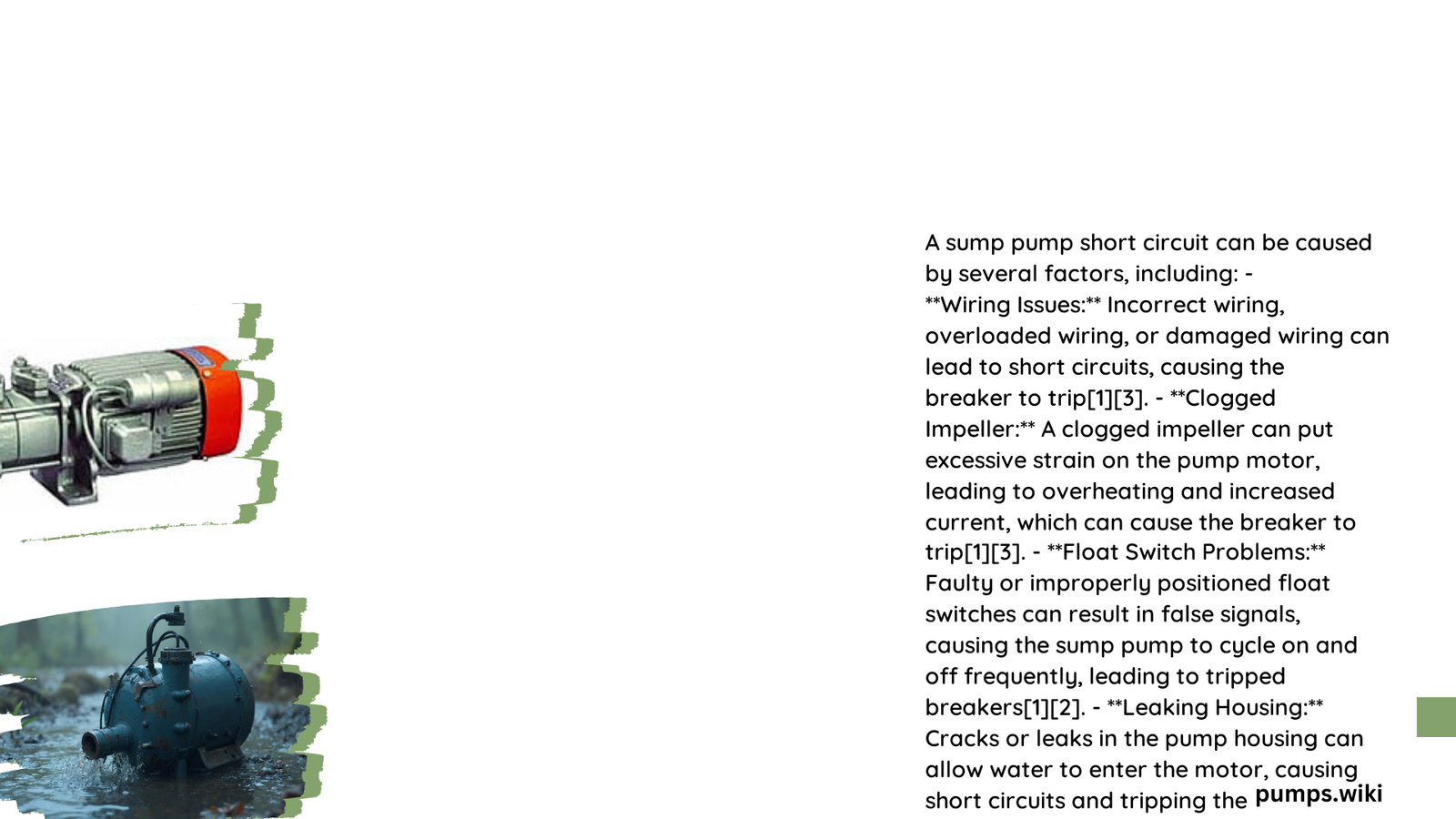A sump pump short circuit occurs when electrical current flows through an unintended path, potentially damaging the pump and posing safety risks. This issue can arise from various factors, including wiring problems, motor overload, or water infiltration. Understanding the causes, symptoms, and solutions for sump pump short circuits is crucial for maintaining a functional and safe basement drainage system.
What Are the Common Causes of a Sump Pump Short Circuit?
Sump pump short circuits can stem from several sources:
- Faulty Wiring: Damaged or improperly installed wires can lead to short circuits.
- Water Infiltration: For submersible pumps, cracks in the housing can allow water to contact electrical components.
- Motor Overload: Excessive strain on the pump motor, often due to clogs or debris, can cause overheating and short circuits.
- Malfunctioning Float Switch: A stuck or faulty float switch can cause the pump to run continuously, leading to overheating.
- Age and Wear: Over time, components can degrade, increasing the risk of electrical issues.
How Can You Identify Symptoms of a Sump Pump Short Circuit?

Recognizing the signs of a potential short circuit is crucial for prompt intervention:
- Tripped Circuit Breaker: The most immediate sign of a short circuit.
- Burning Smell: An electrical burning odor may indicate overheating or wire damage.
- Unusual Noises: Buzzing, humming, or crackling sounds can suggest electrical problems.
- Visible Damage: Inspect for melted plastic, scorch marks, or exposed wires.
- Pump Failure: The pump may stop working altogether due to electrical issues.
What Are the Steps to Diagnose a Sump Pump Short Circuit?
Follow these steps to diagnose a potential short circuit:
- Safety First: Always disconnect power before inspecting the pump.
- Visual Inspection: Check for visible damage to wires, connections, and the pump housing.
- Test the Circuit: Use a multimeter to check for proper voltage and continuity.
- Inspect the Float Switch: Ensure it moves freely and activates/deactivates the pump correctly.
- Check for Clogs: Remove any debris that might be causing the pump to overwork.
- Examine the Impeller: Look for damage or obstructions in the impeller.
How Can You Prevent Sump Pump Short Circuits?
Preventive measures can significantly reduce the risk of short circuits:
- Regular Maintenance: Clean and inspect the pump at least annually.
- Proper Installation: Ensure the pump is installed correctly with appropriate wiring.
- GFCI Protection: Use a Ground Fault Circuit Interrupter outlet for added safety.
- Waterproofing: For submersible pumps, regularly check and maintain the waterproof seal.
- Backup Power: Consider a battery backup to prevent overload during power outages.
What Are the Repair Options for a Sump Pump Short Circuit?
When faced with a short circuit, consider these repair options:
- Wire Replacement: Replace damaged or frayed wires.
- Motor Repair/Replacement: If the motor is damaged, it may need professional repair or replacement.
- Float Switch Replacement: Install a new float switch if the current one is malfunctioning.
- Pump Replacement: In some cases, replacing the entire pump may be more cost-effective than repairs.
| Repair Option | Estimated Cost | Difficulty Level |
|---|---|---|
| Wire Replacement | $50 – $150 | Moderate |
| Motor Repair | $100 – $250 | High |
| Float Switch Replacement | $30 – $100 | Low to Moderate |
| Pump Replacement | $200 – $500+ | Moderate |
When Should You Call a Professional for Sump Pump Short Circuits?
Consider professional help in these situations:
- You’re uncomfortable working with electrical systems
- The short circuit persists after basic troubleshooting
- There’s visible damage to the pump or wiring
- The pump is under warranty, and DIY repairs might void it
- You suspect issues with your home’s electrical system beyond the pump
Remember, electrical work can be dangerous. If you’re unsure about any aspect of diagnosing or repairing a sump pump short circuit, it’s always best to consult with a licensed electrician or plumber.
By understanding the causes, symptoms, and solutions for sump pump short circuits, you can better maintain your home’s drainage system and prevent potential water damage. Regular maintenance and prompt attention to electrical issues will ensure your sump pump continues to protect your basement effectively.
References:
1. Stream Pumps: Why My Sump Pump Keeps Tripping Breaker?
2. Star Water Systems: How to Fix 4 Common Sump Pump Problems
3. Drycrete: Common Causes of Sump Pump Failure and How to Fix Them
